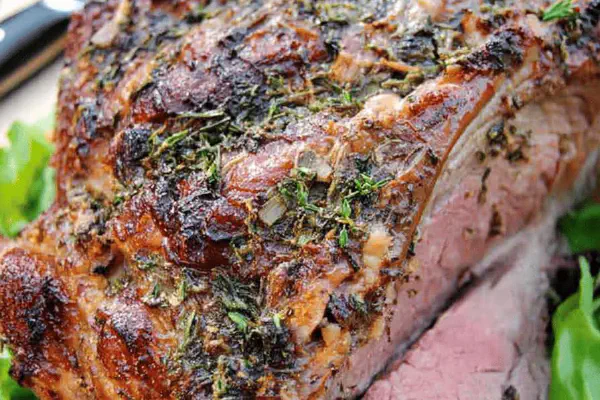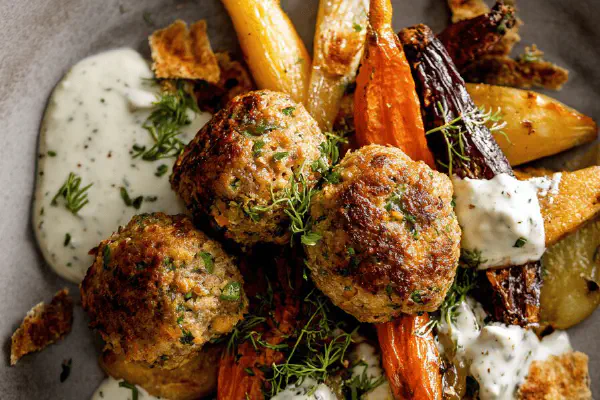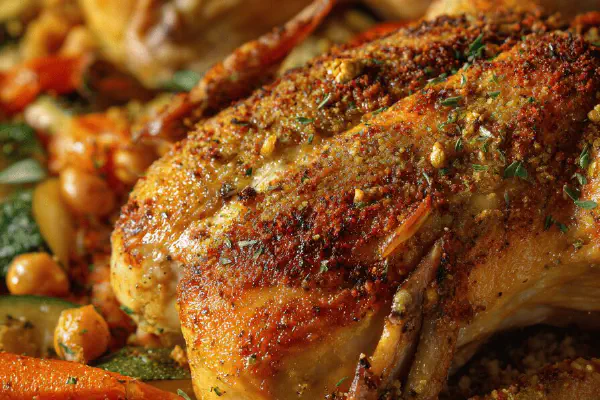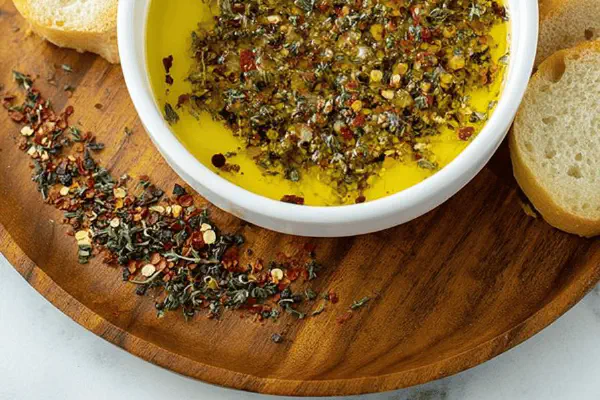Roast Leg Lamb Twist

By Emma
Certified Culinary Professional
Ingredients
- 1 boneless leg of lamb, about 3 1/2 pounds
- 2 tablespoons light extra virgin olive oil plus more for greasing
- 4-5 large garlic cloves, thinly sliced
- 1 teaspoon coarse sea salt
- 1 teaspoon freshly ground black pepper
- 3 tablespoons Dijon mustard
- 2 tablespoons fresh sage, finely chopped (substituted for rosemary)
- 1 tablespoon fresh thyme, chopped
- Fresh herb sprigs to line pan, such as sage, thyme, or oregano
About the ingredients
Method
- Preheat oven to 510 degrees. Coat bottom of 9x13 roasting pan with a light layer of olive oil, just enough to prevent sticking; scatter fresh herb sprigs evenly for aroma bed.
- Lay lamb on cutting board. Use sharp knife, pierce deeply 1/2 inch slits across the lamb’s surface, enough to hold garlic slices snugly. Insert garlic cloves into each opening.
- Season lamb evenly with coarse sea salt and fresh ground pepper, rub thoroughly.
- Slather Dijon mustard over entire lamb surface; this sticks herbs and creates crust base.
- Press sage and thyme firmly into mustard so herbs cling well, they’ll flavor crust.
- Place lamb atop herb bed in roasting pan.
- Pop pan into oven at full blast 510 degrees for 21 minutes. Listen for faint sizzle, smell must start shifting from raw to toasted herbs and garlic; crust begins to form, browning edges visible.
- Quickly open oven to vent, drop temp to 340 degrees. Shut door fast to avoid heat loss then slow roast for 38-63 minutes depending on size and doneness goals.
- Feel roast’s external firmness; jiggle gently. For medium-rare, slight bounce with resistance. Use instant read thermometer if unsure—aim 130-135 degrees internal.
- Remove from oven before it overcooks; crust darkens, garlic softens, and aroma deepens. Lamb rests uncovered on plate or cutting board for 13 minutes to let juices redistribute.
- Carve against the grain thinly with sharp knife. Serve with mint jelly on side—sharp sweetness cuts through lamb’s richness.
- If herbs get too dark or garlic blackens, reduce oven temp slightly for next time. Tried sage here instead of rosemary for earthier note, prefer personal twist over classic always.
- Visualization vital. Watch crust develop from shiny yellow mustard gloss into matte toasted layer. Listen for crackling fat, smell optimize savory notes. Texture will tell doneness far better than clock alone.
Cooking tips
Chef's notes
- 💡 Start oven at blazing high temp, 510 degrees; crust forms quick. Watch edges brown fast, cracks pop softly. Open oven fast after 20 minutes to vent superheat; no delay or crust burns. Slow roast follows. Timing depends on size, feel roast firmness. Instant read thermometer helps but touch test first.
- 💡 Pierce deeply 1/2 inch slits for garlic slices. Crowding clumps flavors, tear meat. Garlic size varies; if tender, fewer cloves; potent bulbs mean more spacing. Salt rub before mustard crucial draws moisture out; helps crust hold better. Herbs pressed in mustard stick solid; dry herbs crumble and fall off, lose aroma.
- 💡 Olive oil just bottom of pan, not full coat lamb. Prevents soggy herb bed yet aromatics smoke up oven. Fresh herb sprigs under lamb make smoke layer; sage stronger than rosemary, earthier wood notes; thyme keeps freshness bright. Mustard base mild acidity, not thick or crust mutes garlic punch.
- 💡 Listen for sizzle, crackle as signs roasting right. Roast’s crust texture guides doneness more than clock. Jiggle roast, feel bounce for medium-rare; resist too soft or too firm. Pull before overcooked or garlic blackens. Rest uncovered 13 minutes minimum, juices settle or slices dry. Carve across grain thin for tender bites.
- 💡 Mint jelly side is counterpoint; sweetness cuts fatty richness sharply, refreshing palate. Garlic blackening means oven too hot or time too long; dial temp down next time. Crust color shifts from shiny to matte toasted; visualize often. Oven variables differ, watch aromatics closely. Adapt as needed, not locked times.
Common questions
How to check doneness without thermometer?
Use touch; gently jiggle roast. Medium-rare feels slight bounce with resistance. Firm means more done, too soft undercooked. Visual cues like crust color matter too. Smell garlic, herbs, listen for sizzle fade. Timing gives baseline but senses beat clock.
Can rosemary replace sage here?
Sure but sage earthier, woodier, changes taste noticeably. Rosemary sharper pine note, thyme still needed. If no sage, more thyme or oregano to fill gap. Fresh herbs preferred; dry herbs lose potency and don’t cling well in mustard crust.
What to do if garlic blackens?
Pull roast earlier or lower oven temperature after initial sear. Garlic burns fast if too hot or exposed. Consider thinner garlic slices or fewer cloves. Alternatively, wrap lamb loosely in foil in last 10 minutes to shield. Adjust timings next cook based on garlic color and aroma.
How best to store leftovers?
Wrap slices tightly in foil or airtight container. Refrigerate within two hours. Use within 3 days max or freeze. Reheat gently, covered, low oven or stovetop to avoid drying. Mint jelly stores separately in fridge. Avoid microwaving lamb; dries and toughens texture.



